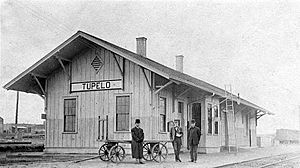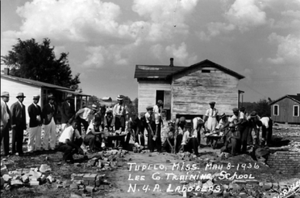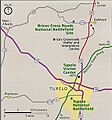Tupelo, Mississippi facts for kids
Quick facts for kids
Tupelo, Mississippi
|
||
|---|---|---|
| City of Tupelo | ||
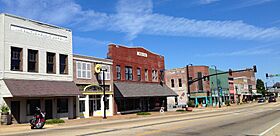
Downtown Tupelo
|
||
|
||
| Motto(s):
"All-America City"
|
||
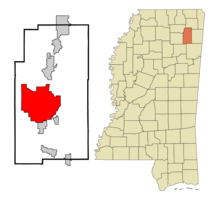
Location in Lee county and Mississippi
|
||
| Country | ||
| State | ||
| County | Lee | |
| Districts | 1, 2, 3, 4, 5 | |
| Founded | October 18, 1860 | |
| Incorporated | July 20, 1870 | |
| Named for | Tupelo | |
| Government | ||
| • Type | Mayor–Council | |
| Area | ||
| • City | 64.68 sq mi (167.53 km2) | |
| • Land | 64.38 sq mi (166.75 km2) | |
| • Water | 0.30 sq mi (0.78 km2) | |
| Elevation | 279 ft (85 m) | |
| Population
(2020)
|
||
| • City | 37,923 | |
| • Density | 589.02/sq mi (227.42/km2) | |
| • Metro | 140,460 (US: 4th) | |
| Time zone | UTC−6 (CST) | |
| • Summer (DST) | UTC−5 (CDT) | |
| ZIP code(s) |
38801, 38804, 38826, 38866
|
|
| Area code(s) | 662 | |
| FIPS code | 28-74840 | |
| GNIS feature ID | 678931 | |
| Highways |
|
|
| Major airport | Memphis Airport (MEM) | |
Tupelo (pronounced TOO-pə-loh) is a city in Mississippi, United States. It is the main city of Lee County. The city was founded in 1860. In 2020, about 37,923 people lived there.
Tupelo is the 7th largest city in Mississippi. It is an important center for business, industry, and culture in northern Mississippi. The city was officially formed in 1870. Before that, it was known as "Gum Pond" because of the many tupelo trees in the area.
On February 7, 1934, Tupelo became the first city to get electricity from the Tennessee Valley Authority (TVA). This earned it the nickname "The First TVA City." In 1936, a very strong tornado hit Tupelo, causing a lot of damage and loss of life. This tornado is still one of the deadliest in American history.
After getting electricity, Tupelo grew quickly as a center for making and distributing goods. It was once famous for its furniture manufacturing. Even though some factories have closed, Tupelo continues to grow thanks to its strong healthcare, retail, and financial services. It is the smallest city in the U.S. that is home to more than one bank with over $10 billion in assets.
Tupelo has a rich music history. It is famous as the birthplace of Elvis Presley. The city has many art and cultural places, including the Elvis Presley Birthplace and the Cadence Bank Arena. This arena can hold 10,000 people and is the largest indoor arena in Mississippi. Tupelo is the only city in the Southern U.S. to win the All-America City Award five times. Its downtown program also won a national award in 2020.
The area around Tupelo, including Lee, Itawamba, and Pontotoc counties, had about 140,081 people in 2017.
Contents
History of Tupelo
Early Settlement
Long before Europeans arrived, Chickasaw and Choctaw people lived in this area. French and British traders worked with these Native American groups. Sometimes, European powers fought each other. In 1736, the Battle of Ackia happened near what is now Tupelo. British and Chickasaw soldiers successfully defended against a French and Choctaw attack.
In the early 1800s, more European-American settlers moved into the area. This led to conflicts over land. In 1830, the U.S. government passed the Indian Removal Act. This law forced many Native Americans from the Southeast to move west of the Mississippi River.
In its early days, settlers called the town "Gum Pond." This name came from the many tupelo trees, also known as "blackgum" trees, that grew there. Today, the city still holds an annual Gumtree Arts Festival.
Civil War and Growth
During the American Civil War, Union and Confederate armies fought near Tupelo in 1864. This battle is now remembered at the Tupelo National Battlefield. Another important Civil War battle happened nearby at Brices Cross Roads National Battlefield.
After the war, a new railroad was built through the town. This helped Tupelo grow and brought new industries. The town then changed its name to Tupelo, honoring the battle that took place there. It officially became a city in 1870.
20th Century Changes
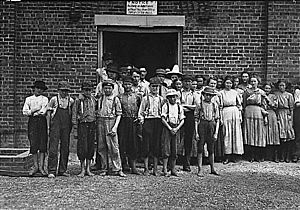
By the early 1900s, Tupelo had cotton textile mills. These mills offered jobs to people from the countryside. However, due to segregation laws at the time, only white adults and children worked in these mills.
During the Great Depression, Tupelo became the first city to get electricity from the new Tennessee Valley Authority (TVA). The TVA built dams and power plants to bring electricity to many rural areas. President Franklin Roosevelt visited Tupelo in 1935 to see this "First TVA City."
In the late 1950s, several long-distance trains served Tupelo. These trains connected the city to places like St. Louis, Mobile, Kansas City, and Jacksonville. The last passenger train left northeast Mississippi in 1967.
In 2007, a nearby village called Blue Springs was chosen for a new Toyota car manufacturing plant.
Presidents have also visited Tupelo. Donald Trump held campaign rallies in the city in 2018 and 2019. These events were shown on national television.
Severe Weather Events
In April 1936, Tupelo experienced one of its worst natural disasters. A powerful tornado, part of the Tupelo-Gainesville tornado outbreak, struck the city. The storm destroyed 48 city blocks and over 200 homes. It killed 216 people and injured more than 700. The tornado hit at night, wiping out many homes on the north side of the city. Among the survivors was baby Elvis Presley. This tornado is one of the deadliest in U.S. history.
The area is often affected by tornadoes. On May 8, 2008, an EF3 tornado hit the town. On April 28, 2014, another large EF3 tornado caused significant damage. On May 2, 2021, two EF1 tornadoes formed near Tupelo. One of them hit the northwest side of downtown.
Geography and Climate
Tupelo is in northeast Mississippi, north of Columbus. It is located on Interstate 22 and U.S. Route 78. The city is about halfway between Memphis, Tennessee and Birmingham, Alabama.
The city covers about 64.68 square miles (167.53 square kilometers). Most of this area is land, with a small amount of water.
Tupelo's Climate
Tupelo has a humid subtropical climate. This means it has hot, humid summers and mild winters.
- The average temperature in January is about 43.4°F (6.3°C).
- The average temperature in July is about 82.3°F (27.9°C).
- Temperatures can reach 90°F (32°C) or higher about 67 days a year.
- The highest temperature ever recorded was 109°F (43°C) in July 1930.
- The lowest temperature ever recorded was -14°F (-26°C) in January 1940.
Tupelo gets a lot of rain, averaging about 57.74 inches (1467 mm) each year. December is usually the wettest month. Snow is rare, with most years getting very little or no snowfall.
People of Tupelo
| Historical population | |||
|---|---|---|---|
| Census | Pop. | %± | |
| 1870 | 618 | — | |
| 1880 | 1,008 | 63.1% | |
| 1890 | 1,477 | 46.5% | |
| 1900 | 2,118 | 43.4% | |
| 1910 | 3,881 | 83.2% | |
| 1920 | 5,055 | 30.2% | |
| 1930 | 6,361 | 25.8% | |
| 1940 | 8,212 | 29.1% | |
| 1950 | 11,527 | 40.4% | |
| 1960 | 17,221 | 49.4% | |
| 1970 | 20,471 | 18.9% | |
| 1980 | 23,905 | 16.8% | |
| 1990 | 30,685 | 28.4% | |
| 2000 | 34,211 | 11.5% | |
| 2010 | 34,546 | 1.0% | |
| 2020 | 37,923 | 9.8% | |
| U.S. Decennial Census 2018 Estimate |
|||
In 2020, Tupelo had 37,923 residents. There were 14,751 households and 9,648 families living in the city.
The people of Tupelo come from diverse backgrounds:
- About 52.9% of residents were White.
- About 37.13% were Black or African American.
- About 1.75% were Asian.
- About 4.93% were Hispanic or Latino.
- Other groups made up the rest of the population.
In 2010, the city had 35,456 people. About 58.7% were White, and 36.8% were African American.
Tupelo's Economy
Tupelo has always been an important transportation center because of its location at a railroad crossing. Today, it also has a strong tourism industry, especially because of the Elvis Presley birthplace and the Natchez Trace Parkway. The city has also attracted many manufacturing, retail, and distribution businesses.
Key Industries and Businesses
- The North Mississippi Medical Center is based in Tupelo. It is the largest non-city hospital in the United States. It serves people from northern Mississippi, northwest Alabama, and parts of Tennessee. The medical center has won national awards for its quality.
- Tupelo is home to the headquarters of two large banks: Cadence Bank and Renasant Bank. Each of these banks manages billions of dollars. Tupelo is the smallest U.S. city to have more than one bank headquarters with over $10 billion in assets.
- The city has won the "All-America City Award" five times.
- In 1963, the company that would become Comcast (a large cable operator) started in Tupelo.
- Tupelo has a big furniture manufacturing industry. This industry provides thousands of jobs in the region.
- Many companies have operations or headquarters in Tupelo and Lee County. These include Tecumseh, Heritage Home Group, and Toyota Motor Manufacturing Mississippi.
Arts and Culture
Tupelo offers many cultural and historical attractions for visitors and residents.
- The Tupelo Buffalo Park and Zoo is home to a large herd of American bison. It also has other interesting animals like emus and pythons.
- The city is the headquarters of the historic Natchez Trace Parkway. This scenic road connects Natchez, Mississippi, to Nashville, Tennessee. It follows an ancient trail used by Native Americans for thousands of years.
- Nearby are the Pharr Mounds. These are ancient burial mounds built by indigenous peoples almost 2000 years ago.
- You can visit Civil War sites like the Tupelo National Battlefield and Brices Cross Roads National Battlefield Site.
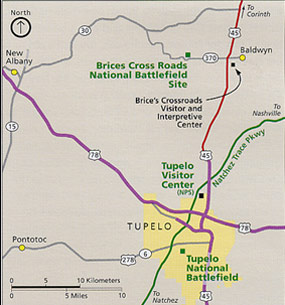
- The Tupelo Automobile Museum used to be one of the largest in North America. It was the official automobile museum of Mississippi. It had over 150 rare cars. The museum closed in 2019, and the cars were sold.
- The Tupelo Community Theatre has been putting on plays since 1969. It has won awards for its performances. The theater is located in the historic Lyric Theatre, which was built in 1912.
- The North Mississippi Symphony Orchestra performs concerts from September to April. They also hold a free outdoor concert every July 4th that attracts many people.
- A statue honoring Chief Piomingo, a leader of the Chickasaw people, was put in front of the new Tupelo City Hall in 2005.
- The Oren Dunn City Museum tells the story of how the community was built. It has exhibits and historic buildings.
- In 1956, Elvis Presley returned to Tupelo for a concert. This event is celebrated every year at the "Elvis Presley Festival." The documentary film The Homecoming: Tupelo Welcomes Elvis Home was shown at the 2006 festival.
- The Lee County Library in downtown Tupelo has a special section for genealogy research. It also hosts an annual lecture series with famous authors.
- The Church Street Elementary School, built in 1937, was known for its modern design. A model of this school was shown at the 1939 New York World's Fair.
- The Cadence Bank Arena opened in 1993. It is a large venue for concerts and other events.
- Tupelo has been mentioned in songs by artists like John Lee Hooker, Nick Cave and the Bad Seeds, Taylor Swift, and Jason Isbell.
Education in Tupelo
The Tupelo Public School District serves most of Tupelo. Students in grades 6 to 12 are given a school-owned Google Chromebook to use during the school year. In 2008, Sports Illustrated ranked Tupelo High School's sports program as the third-best in the nation. Tupelo High School is the largest public high school in Mississippi.
Some parts of Tupelo are served by the Lee County School District.
For higher education, Tupelo has satellite campuses of the University of Mississippi, Itawamba Community College, and the Mississippi University for Women.
Media and News
Tupelo has a local daily newspaper called the Northeast Mississippi Daily Journal. There is also a weekly newspaper, the Lee County Courier.
The city is home to several television stations:
The American Family Association, a Christian organization, is located in Tupelo. It runs the national American Family Radio network.
Transportation
Rail Transport
Tupelo is served by BNSF Railway and Kansas City Southern Railway. These companies transport goods by rail.
Roads
Several major roads pass through Tupelo:
- U.S. Route 45
- U.S. Route 78
- U.S. Route 278
- Natchez Trace Parkway
- Interstate 22 runs north of the city.
Air Travel
The city has its own airport, Tupelo Regional Airport. It offers flights through Contour Airlines.
Notable People from Tupelo
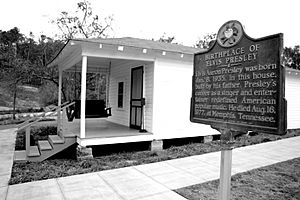
- John Mills Allen (1846–1917), U.S. congressman
- Sharion Aycock (born 1955), American judge
- Alex Carrington (born 1987), American football player
- Dave Clark (born 1962), baseball player and coach
- Diplo (born 1978), musical artist
- Brian Dozier (born 1987), baseball player
- Ally Ewing (born 1992), golfer
- Etta Zuber Falconer (1933-2002), mathematician
- Sam Gilliam (born 1933), artist
- Allie Grant (born 1994), film actress
- Jarious Jackson (born 1977), American football player
- Arthur Jafa (born 1960), video artist
- Todd Jordan (born 1970), professional football player and Tupelo mayor
- Slim Jxmmi (born 1991), hip-hop artist
- Catherine Lacey (born 1985), author
- Swae Lee (born 1993), hip-hop artist
- John Murry (born 1979), singer-songwriter
- Elvis Presley (1935–1977), famous singer and actor
- John E. Rankin (1882-1960), U.S. Congressman
- Paul Rudish (born 1968), animator and writer
- Jumpin' Gene Simmons (1933–2006), singer
- Chris Stratton (born 1990), baseball player
- Paula White (born 1966), American preacher and author
- Roger Wicker (born 1951), U.S. senator
- Brandon Woodruff (born 1993), baseball player
Images for kids
See also
 In Spanish: Tupelo (Misisipi) para niños
In Spanish: Tupelo (Misisipi) para niños




